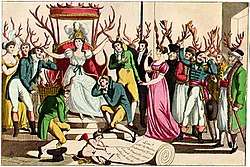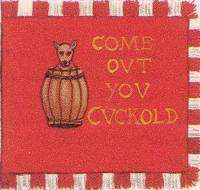Cuckold
A cuckold is the husband of an adulterous wife. In evolutionary biology, the term is also applied to males who are unwittingly investing parental effort in offspring that are not genetically their own.[1]
History of the term

The word cuckold derives from the cuckoo bird, alluding to its habit of laying its eggs in other birds' nests.[2][3] The association is common in medieval folklore, literature, and iconography.
English usage first appears about 1250 in the satirical and polemical poem The Owl and the Nightingale (l. 1544). The term was clearly regarded as embarrassingly direct, as evident in John Lydgate's "Fall of Princes" (c. 1440). In the late 14th century, the term also appeared in Geoffrey Chaucer's "The Miller's Tale".[3] Shakespeare's poetry often referred to cuckolds, with several of his characters suspecting they had become one.[3]
One often-overlooked subtlety of the word is that it implies that the husband is deceived, that he is unaware of his wife's unfaithfulness and may not know until the arrival or growth of a child plainly not his (as with cuckoo birds).[3]
The female equivalent cuckquean first appears in English literature in 1562,[4][5] adding a female suffix to the cuck.
A related word, first appearing in 1520, is wittol, which substitutes wit (in the sense of knowing) for the first part of the word, referring to a man aware of and reconciled to his wife's infidelity.[6]
Metaphor and symbolism

In Western traditions, cuckolds have sometimes been described as "wearing the horns of a cuckold" or just "wearing the horns". This is an allusion to the mating habits of stags, who forfeit their mates when they are defeated by another male.[7] In Italy (especially in Southern Italy, where it is a major personal offence), the insult is often accompanied by the sign of the horns. In French, the term is "porter des cornes", which is used by Molière to describe someone whose consort has been unfaithful. In German, the term is "jemandem Hörner aufsetzen", or "Hörner tragen", the husband is "der gehörnte Ehemann". Rabelais wrote the Tiers Livers of Gargantua and Pantagruel in 1546, by which time the symbol of the horns was "so well-known and over-used that the author could barely avoid making reference to it".[8] Molière's L'École des femmes (1662) is the story of a man who mocks cuckolds and becomes one at the end. In Geoffrey Chaucer's Canterbury Tales (c. 1372–77), "The Miller's Tale" is a story that humorously examines the life of a cuckold. In Chinese usage, an altogether different allusion is used, when the cuckold (or wittol) is said to be "戴綠帽子" (wearing the green hat), which derives from the sumptuary laws used in China from the 13th to the 18th centuries that required the males in households with prostitutes to wrap their heads in a green scarf (or later a hat).[9]
The term cuck in politics
An abbreviation of cuckold, the term cuck has been used by the alt-right to attack the masculinity of an opponent. It was originally aimed at other conservatives, whom the alt-right saw as ineffective.[10]
Cuckoldry as a fetish
Unlike the traditional definition of the term, in fetish usage a cuckold is complicit in his (or her) partner's sexual "infidelity"; the wife who enjoys cuckolding her husband is called a cuckoldress if the man is more submissive.[11][12][13] If a couple can keep the fantasy in the bedroom, or come to an agreement where being cuckolded in reality does not damage the relationship, they may try it out in reality. However, the primary proponent of the fantasy is almost always the one being humiliated, or the "cuckold": the cuckold convinces his lover to participate in the fantasy for them, though other "cuckolds" may prefer their lover to initiate the situation instead. The fetish fantasy does not work at all if the cuckold is being humiliated against their will.[14]
Theory
Psychology regards cuckold fetishism as a variant of masochism, the cuckold deriving pleasure from being humiliated.[15][16] In Freudian analysis, cuckold fetishism is the eroticization of the fears of infidelity and of failure in the man's competition for procreation and the affection of females. In his book Masochism and the Self, psychologist Roy Baumeister advanced a Self Theory analysis that cuckolding (or specifically, all masochism) was a form of escaping from self-awareness, at times when self-awareness becomes burdensome, such as with perceived inadequacy. According to this theory, the physical or mental pain from masochism brings attention away from the self, which would be desirable in times of 'guilt, anxiety, or insecurity', or at other times when self-awareness is unpleasant.[17]
See also
References
- ↑ Steven M. Platek and Todd K. Shackelford (Eds.), Female Infidelity and Paternal Uncertainty: Evolutionary Perspectives on Male Anti-Cuckoldry Tactics. Cambridge University Press: New York, 2006.
- ↑ "Online Etymology Dictionary". Retrieved 19 December 2016.
- 1 2 3 4 Williams, Janet (4 July 2009). "Cuckolds, Horns and Other Explanations". BBC News. Retrieved 11 February 2013.
- ↑ Coleman, Julie (1 January 1999). "Love, Sex, and Marriage: A Historical Thesaurus". Rodopi. Retrieved 22 November 2016 – via Google Books.
- ↑ Williams, Gordon (13 September 2001). "A Dictionary of Sexual Language and Imagery in Shakespearean and Stuart Literature: Three Volume Set Volume I A-F Volume II G-P Volume III Q-Z". A&C Black. Retrieved 22 November 2016 – via Google Books.
- ↑ Oxford English Dictionary
- ↑ E. Cobham Brewer 1810–1897. Dictionary of Phrase and Fable. 1898.
- ↑ LaGuardia, David P., Intertextual Masculinity in French Renaissance Literature, Ashgate Publishing (Franham, UK 2008) p. 133.
- ↑ Sommer, Matthew Harvey (2002). Sex, Law, and Society in Late Imperial China. Stanford: Stanford University Press. p. 218. ISBN 0-8047-4559-5. Retrieved 2008-07-27.
- ↑ Stack, Liam (August 15, 2017). "Alt-Right, Alt-Left, Antifa: A Glossary of Extremist Language". The New York Times.
- ↑ Ley, David (2009). Insatiable Wives: Women Who Stray and the Men Who Love Them. Rowman & Littlefield. ISBN 978-1-4422-0031-9.
- ↑ Kort, Joe; Psychotherapist, Ph D.; Sex, Certified; Kort, Relationship Therapist at Joe; Associates; www.JoeKort.com, P. C. (13 September 2016). "The Expanding Phenomenon Of Cuckolding: Even Gay Men Are Getting Into It". Huffington Post. Retrieved 19 December 2016.
- ↑ Harris, Lynn. "What do you call a female cuckold?". Salon. Retrieved 19 December 2016.
- ↑ Klein, Donald C. (1 Dec 1999). "The humiliation dynamic: An overview". The Journal of Primary Prevention. 12 (2): 93–121. doi:10.1007/BF02015214.
- ↑ Rufus, Anneli (Jul 29, 2010). "The Intellectual Sex Fetish". The Daily Beast. Retrieved August 30, 2012.
- ↑ "Cuckolding can also be mixed with other non-monogamous relationship arrangements with which it has substantial overlap such as swinging, open relationships, and polyamory. Again, it is distinguished from these concepts in that cuckold’s thrill in their partner’s acts is specifically masochistic.", Betchen, Stephen J., Magnetic Partners blog post, 11/18/14
- ↑ Baumeister, Roy (2014). Masochism and the self. New York: Psychology Press. ISBN 978-1138876064.
External links
| Look up cuckold in Wiktionary, the free dictionary. |
- Una McIlvenna (December 20, 2017). "From the 16th-century to men's rights activists: The history of the insult 'cuckold'". ABC. Retrieved December 20, 2017.